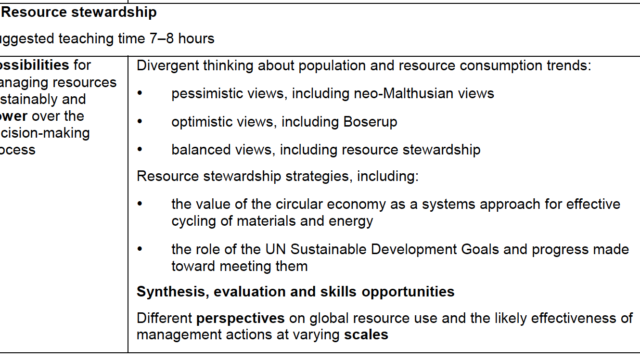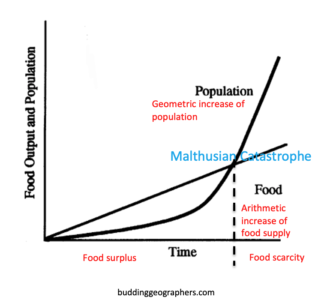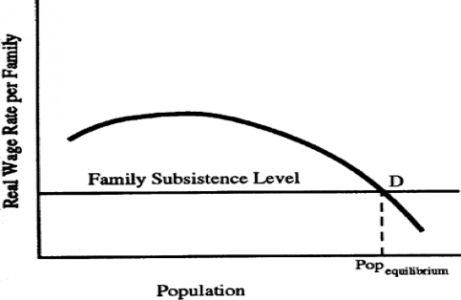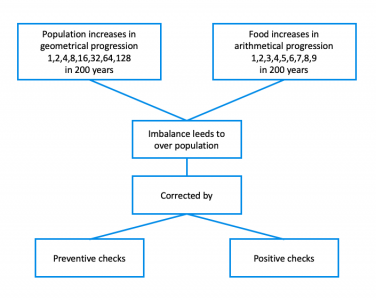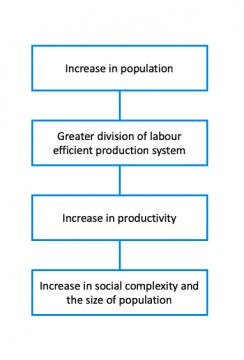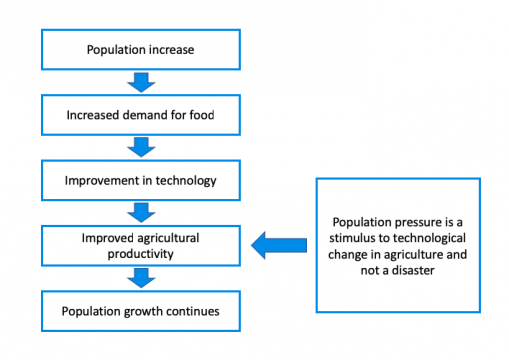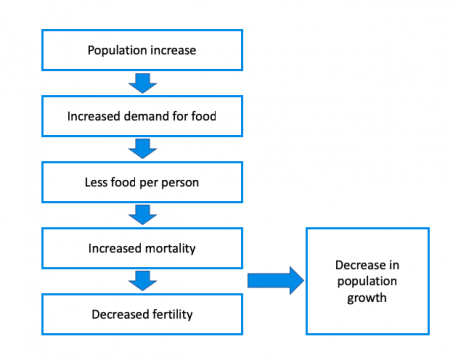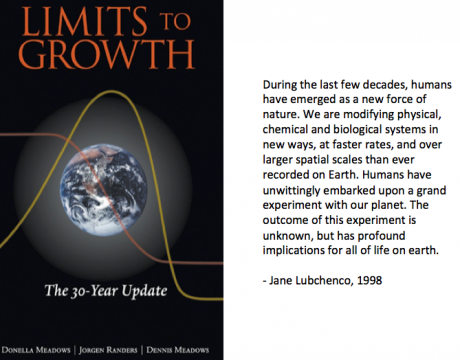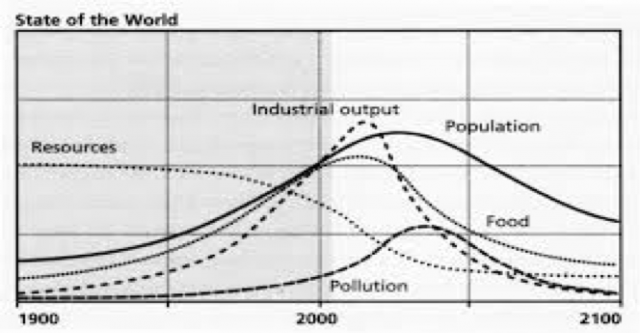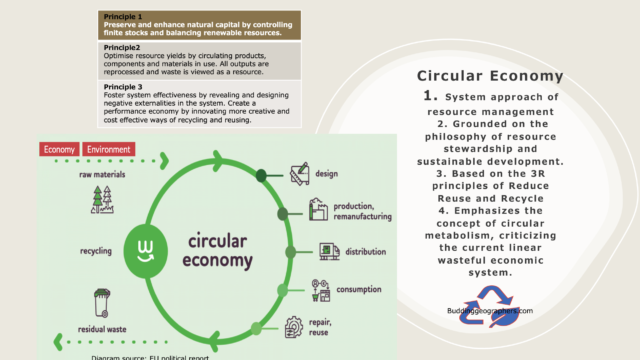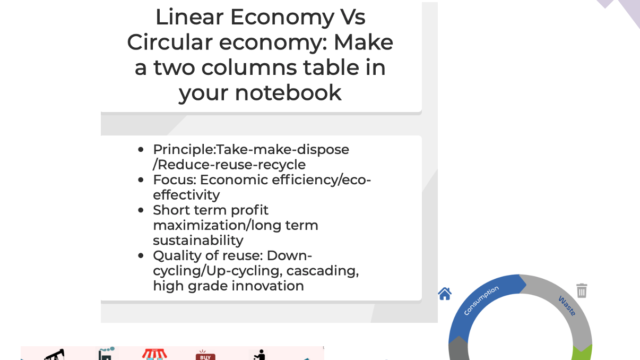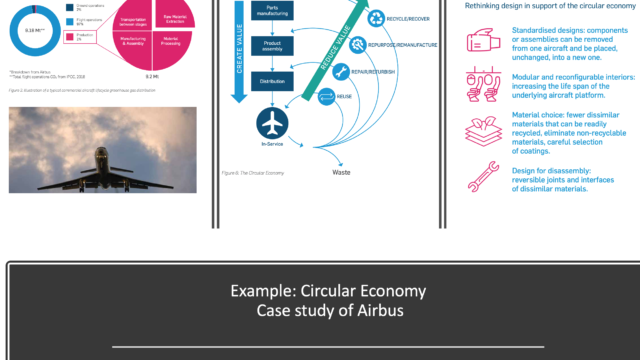Pessimistic views
Thomas Robert Malthus (1766-1834), theory of population
Essay on the Principle of Population (1798)
- Thomas Robert Malthus was born near Guildford (England) in 1766. Malthus went on to Cambridge University, earning a master’s degree and became a professor of history and political economy in Hertfordshire.
- He was the first economist to propose a systematic theory of population. He articulated his views regarding population in his famous book, Essay on the Principle of Population (1798)
Although Reverend Malthus grew up during the Industrial Revolution, he was a product of traditional Europe-that is, preindustrial, pre-growth society. He believed that economic life depended on the productivity of land, so that ultimately it was the land that determined the level of existence.
He believed that there was a finite optimum population size in relation to food supply and that any increase in population beyond this point (Malthusian Catastrophe) would lead to a decline in the standard of living and to war, famine and disease.
His theory was based on two principles:
- In the absence of checks, population would grow at a geometric or exponential rate (1, 2,4,8,16, 32, 64, 128, 254 and so forth)
- Food supply at best only increase at an arithmetic rate (1,2,3,4,5)
Effects on Family size and subsistence level of income
Malthus convinced that the “passion between sexes” would cause men and women to procreate, and as long as there was enough food around to feed a growing family, the family size would increase. If the family does not obtain at least subsistence level of income some of the children will die because the parents would not be able to feed them. Once they fall below point D, widespread famines occur and there would be numerous deaths in the society, according to the Malthusian doctrine
Positive and preventive checks in Malthusian theory
Malthus indicated that the human species was destined to poverty and a life of misery unless the rate of population growth was retarded by positive checks and/or preventive checks. Preventive checks decrease the fertility rate and positive checks increase the death rate.
| preventive checks | positive checks |
|---|---|
| Abstinence from marriage | Lack of food |
| Delay in time of marriage | Disease and war |
| Sexual abstinence and moral restraint | famine |
Malthusian Theory of Population
Criticism of Malthsian View
Not Valid
Still Valid?
Ethiopia is facing the most severe starvation crisis in the world right now, and it is almost entirely manmade. Nearly 350,000 people are threatened by famine in 2021.
Read Article: Ethiopia’s Tigray is facing the world’s worst hunger crisis at present.
Anti Malthusian–Resource Optimist view
Danish economist Esther Boserup (1910-1999) who believed and popularized “necessity is the mother of invention”
Boserup examinated different landuse systems (from shifting cultivation to multicropping system) and their intensity of production. In her famous book, The Conditions of Agricultural Growth: The Economics of Agrarian Change under Population Pressure, Boserup suggested that in a pre-industrial society, an increase in population stimulated a change in agricultural techniques so that more food would be produced. Population growth will thus enable agricultural development to occur.
Increased food production since Malthus time (support for Boserup’s proposition)
There have been many ways since Malthus time by which food production have increased many folds. These include:
- Intensification
- Extensification
- Draining marshland
- Reclaiming land from sea
- Cross breeding and high yield varieties
- Slope terracing
- Greenhouse agriculture
- Improved irrigation techniques
- New food such as soy
- Using artificial fertilizer and pesticides
- Crop diversification etc
Anti-Malthusian: Balanced view of Julian Simon
The Ultimate Resource (1981)
- Simon challenged the Malthusian catastrophe—that an increase in population has negative economic consequences;
- Population growth will drive up demand for resources and the price will rise. High price will encourage entrepreneurs to find out new resources.
- According to Simon, ingenious, resourceful humans had the capacity to invent and to safe guard growing population
Pessimistic views of the Neo-Malthusian (Revival of Malthusian concept)
Paul Ehrlich- the population Bomb, 1968
- Ehrlich, a biologist, maintained that the rate of population growth was outstripping agricultural growth and the capacity for renewal of Earth’s resources.
- Each year food production in the underdeveloped countries falls behind their rapid population growth and people go to bed hungrier.
- The battle to feed all of humanity is over. Population growth on Earth is still too high, and will eventually lead to a serious crisis. He warned that millions of people would starve to death in spite of any crash program embarked upon.
Neo- Malthusian view of the Club of Rome
The club of Rome was a global think tank, comprising heads of the states, high level bureaucrats, diplomats and scientist, economists and business leaders. Club of Rome signifies a group of world citizens, sharing a common concern for the future of humanity.
- Started to act as a global catalyst for change
- Identification and analysis of crucial problems that humanity is facing
- To influence public and private decision makers
- Raised considerable public attention with its report Limit to Growth
Limit to Growth project- commissioned by the Club of Rome
The project was produced by the System Dynamic group of MIT from 1970-1972, funded by Volkswagen Foundation of Germany and was headed by Dennis Meadow and others of MIT.
They used system dynamic theory and computer modelling to predict the earth’s carrying capacity.
The Limit to growth was determined on the basis of the five following factors
- Population
- Agricultural production
- Natural resources
- Industrial production
- Pollution
Many of these factors were observed to grow at an exponential rate. It demonstrates the short period of time within which corrective action to be taken. If the predicted growth is correct then there is an alarmingly short time for preventive action.
Some alarming predictions of Limit to growth model-
- Huge capital would be required to cope with the problems.
- It would become impossible to sustain growth
- End to growth may occur as collapse – an uncontrolled decline in population and human welfare
Beyond the Limit, 1992 Report by Meadows, Randers and Meadows
20 year update –Rio conference 2002 review of the LTG group- Rio+10 conference in Johannesburg
- Growing evidence that humanity is moving further into the unsustainable territory
- To reach sustainability, humanity must increase the sustainable consumption levels of the world‘s poor while at the same time reducing humanity‘s total ecological footprint.
Revival of optimistic research
2004 Study of Paul Ehrlich and Kenneth Arrow
- Central concern has shifted from population growth to consumption ratio
- The idea that growing human numbers will destroy the planet is not significant but over consumption will.
Optimistic view of prof. Hans Rosling in 2010:
It is possible to achieve a balanced population growth and resource relationship through sustainable development and equitable justified consumption.
Your Tasks
Reading: Pp. 108 -109
T1. From page 108, find out 4 major features of the balanced approach: Resource stewardship
T2. From page 109: Find out 3 stewardship action plans as EXAMPLES.
T3. Identify the challenges that may arise with the implementation of your selected stewardship actions.
Practice exam style questions:
- Evaluate how does population growth affect resource availability according to pessimistic views of population resource relationship? (5 marks)
- How do preventive and positive checks negate of-shooting carrying capacity ? (3)
- Explain the limits to growth model? (5 marks)
- Describe a linear economy and a circular economy. (2+2)
- State 3 differences between a linear economy and a circular economy.
- State example of the application of the circular economy at the local scale. (5)
- State an example of the application of the circular economy at the national scale. (5)
- State an example of the application of the circular economy at the global scale. (5)
- How does the circular economy help to address the Sustainable Development Goals? (10)
- Explain the differences between optimistic (Ester Boserup’s) and pessimistic views (Malthus and Neo-Malthus) views on the relationship between population growth and food supply. (10)

